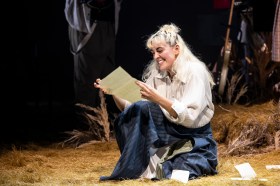At this point, the word ‘unprecedented’ has been used so much to describe the national mood, that it now tastes like the gum at the end of a ten hour shift (once peppermint, now vaguely reminiscent of wall filler putty.) But still, it’s a useful word to encapsulate how the world has never felt this on fire before.
What with the Coronavirus, Black Lives Matter, global warming, and the visible pummelling of democratic institutions, frustration at injustice and tragedy seems to be pressing in on every corner of our lives.
And as artists, many of us are burning with the need to say something about it all. We want to take our anger at the collective tragedies and channel it into our art.
The problem is that this is much more easily said than done, and anger is a famously difficult, devious emotion to work with.
SO HOW DO WE DO IT?
How do we channel anger in our work that doesn’t corrode its artistic value? How do we embody the exquisite visual articulation of pain by Frida Kahlo – not the angry all caps Facebook poet/ranter on our local community page?
Well, we start with by admitting it’s ok to be angry. As artists in Aotearoa, we often get a strange scenario where we’re supposed to let out our demons – and yet when we do, we’re told to tone it down because too much anger is off-putting.
We can probably blame our stoic, sensible second son roots for that. ‘I think especially in middle and upper-class Pākehā culture, it’s all about hiding emotion and suppressing it,’ laughs art therapist and Director of Whitecliffe’s art therapy program, Amanda Levey.
DITCH THE SHAME
In fact, we need to stop being ashamed of that anger because it’s actually a gold mine of creative riches.
‘It’s always good to burn with rage about something,’ argues Massey University senior creative writing tutor and Poetry New Zealand 2020 editor, Johanna Emeney. ‘This usually means that you have sensitive antennae for injustice, and injustice is where most of the good stories live.’
In her view, artists are in a particularly powerful position to make people take notice of injustice. She cites Poetry New Zealand 2020 yearbook featured poet essa may ranapiri’s poem, my dream of a non-binary prison as an example of this.
‘It’s always good to burn with rage about something.’
– Johanna Emeney
By dealing with anger in such a personal way, going beneath it to expose the emotions below, ‘allows readers to understand on a level that they never would were they reading a volatile “rant” on the topic of New Zealand’s lack of prison facilities for people who identify as transgender.’
ranapiri (Tainui takatāpui; they/them/theirs) is also similarly dismissive of the idea we should be ashamed of anger in art. ‘I think this is maybe playing into the colonial myth of objectivity,’ they snort. ‘A lot of the reason we write things is because we feel them.’
Although they do admit that it’s incredibly difficult to harness such raw emotions like anger and frustration. ‘When you’re starting off, it can be very hard to control,’ says ranapiri, ‘and to craft something that works while succumbing to that angry impulse.’
GOOD FOR YOUR MENTAL HEALTH
We also can’t deny that it does feel good to release our anger; ‘there’s definitely a perverse joy in it,’ muses ranapiri. There’s a strong mental health benefit to it too – something worth highlighting as we start Mental Health Awareness Week. We see this in the practice of art therapy, a practice based on the logic that the physical process of art creation can create individual mental change.
‘Arts in therapy have this symbolic and ritualistic importance,’ explains Lowery. ‘If someone creates something they’re angry about, I’ll ask them what they want to do with it. Burn it? Rip it up? Take it to the sea? It becomes a ritualised way of dealing with the emotions.’

Image: Shutterstock
Art has the ability to deal with paradoxes that often come from anger, frustration, and the cost of living in a crazy world. ‘Humans are capable of holding all their paradoxes but it’s a struggle. Art can hold all of that, it can hold multiple truths at the same time,’ she explains.
It can act cathartically on repressed emotions, but also contain overpowering ones, allowing us to move on from being ‘stuck’ on a feeling and allowing new ones to come through. Or as ranapiri puts it, ‘there’s poetry I need to get out or I’ll be stuck in this feeling for weeks.’
KNOW WHAT TO SHARE
The crucial part is separating out art that’s for the audience, and art that’s for personal therapy. It’s vitally important to know who your anger is for – otherwise it’ll ruin a good idea.
Emeney points to Facebook as an example of confusing the two audiences and ruining a good idea. ‘Lots of very bad, ranty posts start out as good ideas. I’m sure of it. But writing in a strongly opinionated way with a therapeutic end-goal is never going to make for good work. Firstly because it is arrogant, and secondly because it is selfish.’
She highlights that the therapeutic intention contradicts what artistic intention sets out to do. ‘Refocus your intention by starting to think about writing as being an art whose aim is to universalise personal experience.’
And this is naturally quite hard to do – because the thrill of therapeutic catharsis can often feel similar to a brilliant flash of artistic insight. It’s why creative writing tutor at Waikato University Tracey Slaughter advised ranapiri, ‘not to write in the emergency room’. If you’re too close to something, which inevitably you are in the heat of frustrated scribbling, it can stop you seeing it clearly. Hence why allowing yourself time to revisit works later, and having someone else give honest feedback, is vital.
ART IS NOT A DUTY
But above all, what’s true for all artists is the need to stay true to the art.
And sometimes, that means fighting the need to automatically persuade or educate, that we can feel the burden of having a ‘platform.’
Despite creating searingly and polemical art about many current social and political issues, ranapira isn’t trying to persuade anyone. ‘I am just trying to describe the truth of the world as I see it, and maybe lift the veil from people’s eyes,’ they say.
Emeney is likewise fierce on both staying close to your personal and artistic truth. ‘You need to do you. Art is not a duty. It is a crazing itch to be scratched and a divine pleasure.’
This article first appeared in The Big Idea (NZ). Read the original article.





